255 villages in C China's Henan Province at extreme risk in the worst floods in more than 50 years: experts

Floods are seen in Longtou village, Dengfeng city of central China's Henan Province, July 20, 2021. Photo: Xinhua
The China Institute of Water Resources and Hydropower Research published on Thursday a report on the unprecedented rainfall in Central China's Henan Province, pointing that 255 villages were at extreme risk in the worst floods in more than 50 years.
According to the report published by the institute on its WeChat account, Henan suffered rare continuous heavy rains since Saturday with long periods of concentrated precipitation and high accumulation.
The daily rainfall broke historical records in Songshan, Xinmi, Xinzheng and other national meteorological observation stations. The rains have caused flooding in the cities and landslides in mountainous areas damaging infrastructure and causing loss of life and property.
The institute organized a team of experts to analyze precipitation levels and floods and evaluate risks in Henan's capital Zhengzhou and its surrounding areas using remote sensing and hydrodynamic models.
By Wednesday morning numerous rivers in the province registered record water levels not seen in the last 50 years and 6,331 villages were under threat of mountain landslides. The area affected by floods reached 4,010 square kilometers.
The cumulative average rainfall was 131 millimeters in the province and 485 mm in Zhengzhou, according to the report, adding that the monsoon and the extremely uneven topography in Henan remain as risks for floods.
According to statistics, torrential rain and floods occur once every two years in Henan on average, and local inundation occurs every year. In the context of global climate change, the probability of extreme rainfall events is increasing and the impact of major disasters is inevitable, read the article.
The institute noted that the mountain landslide disaster monitoring and early warning system and the mass measurement and prevention system in Henan played a good role. However, experts urged China to continue to strengthen the capacity in flood prevention at the grass-roots level and improve monitoring and warning in mountainous areas and in small and medium-sized rivers.



